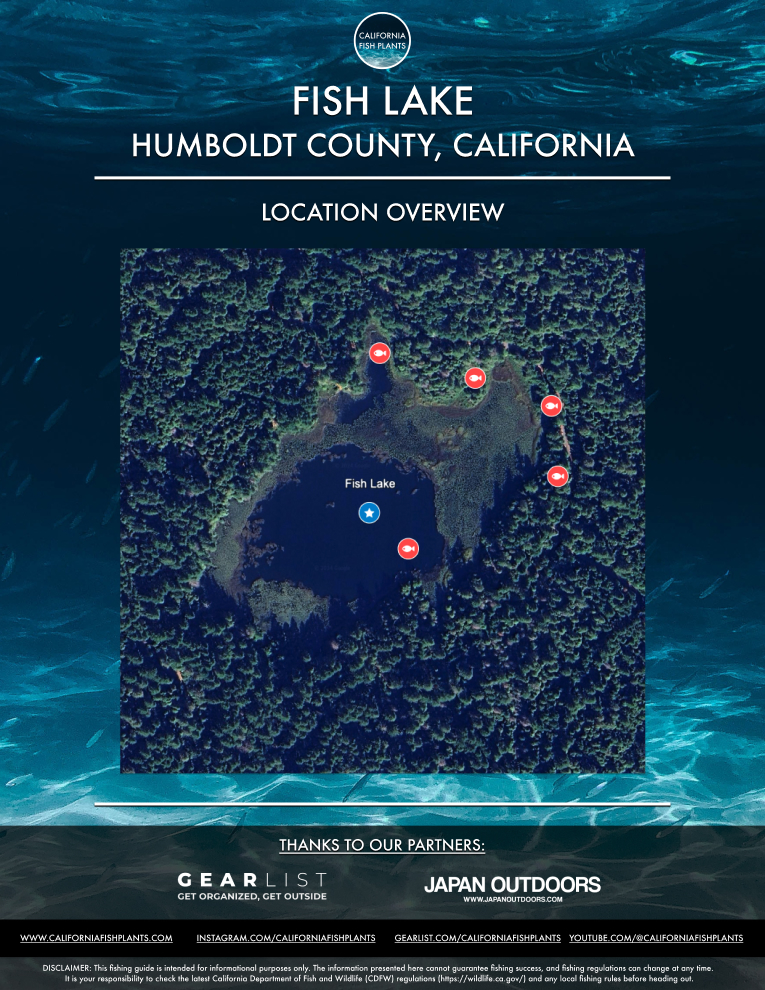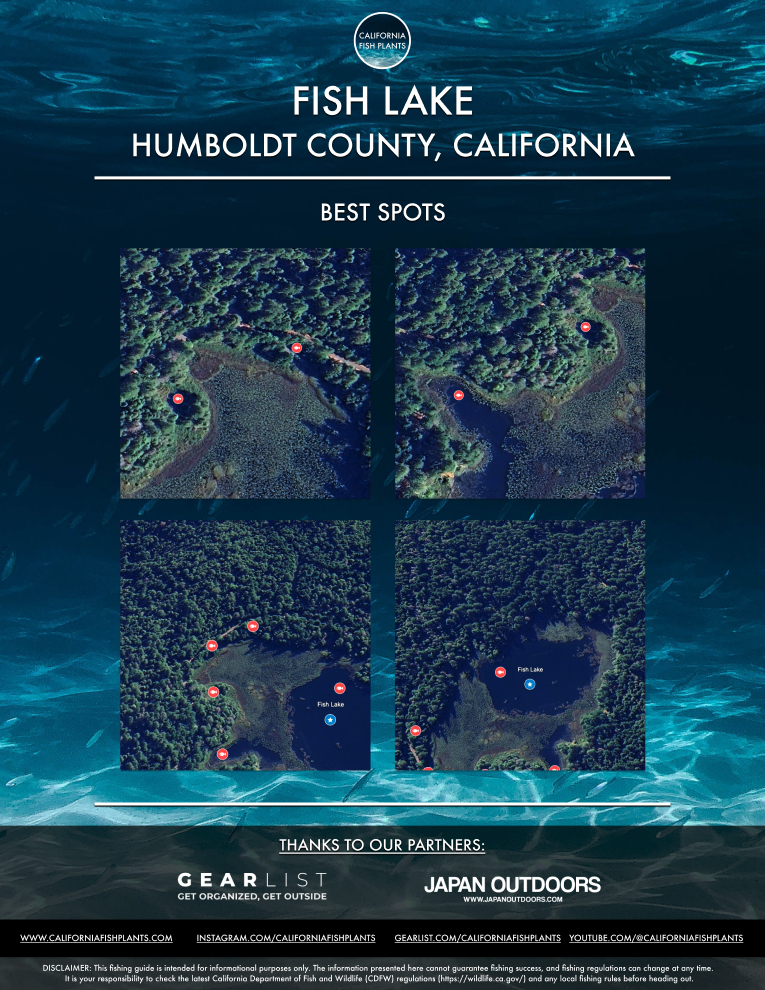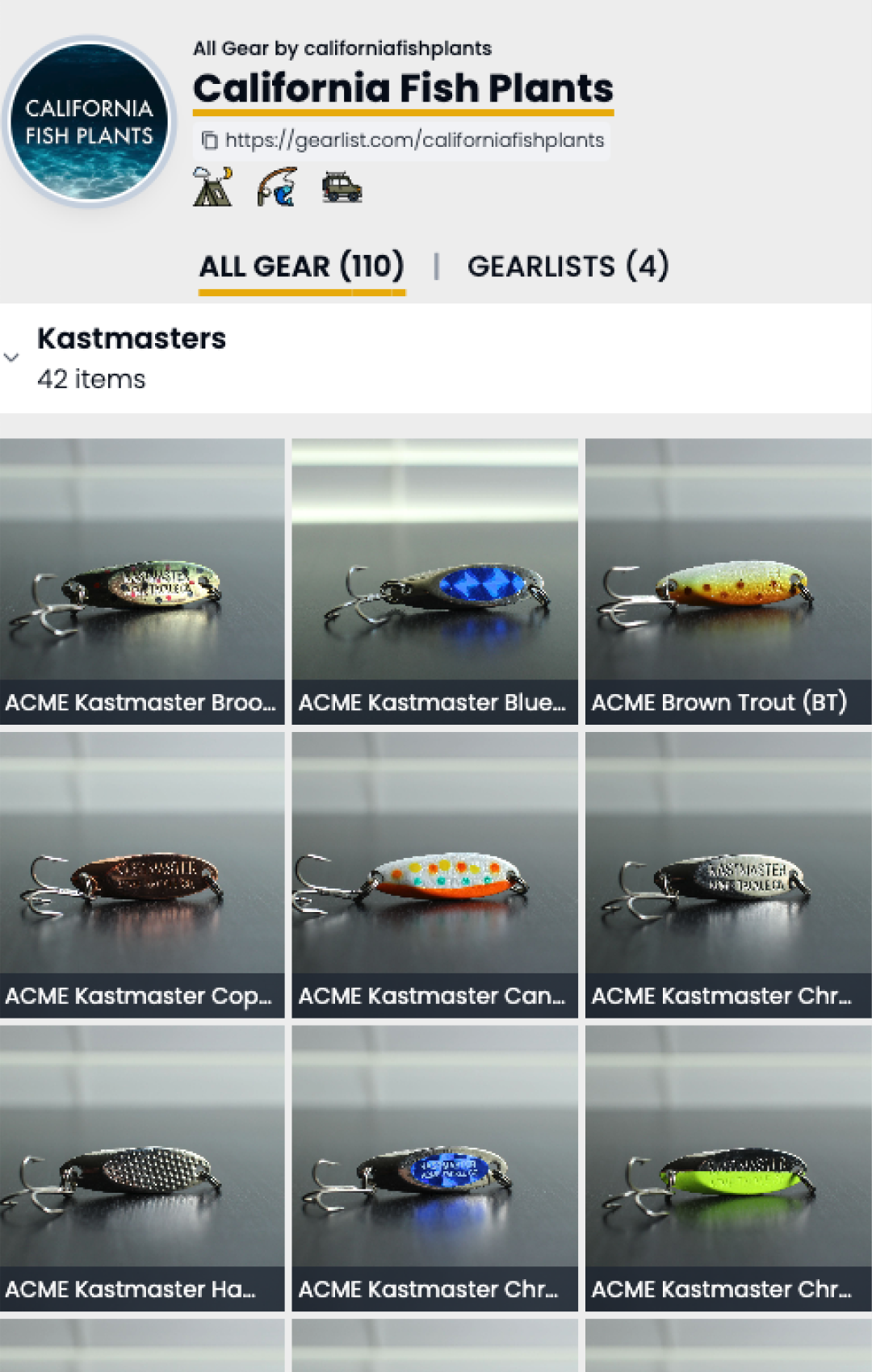Six Rivers National Forest, a vast expanse of pristine wilderness in Northern California, is home to a hidden gem for fishing enthusiasts: Fish Lake. Situated within the boundaries of Shasta and Trinity counties, Fish Lake emerges as a tranquil haven amidst the rugged beauty of the forest. With its sprawling reservoir spanning over 3,000 acres, Fish Lake offers anglers a year-round retreat and a diverse array of fish species to target. In this comprehensive guide, we embark on an exploration of the angler’s paradise that is Fish Lake, uncovering the secrets of its abundant fish populations and sharing expert tips to ensure an optimized fishing experience.
📈 Latest Fish Plants
Fish here often?
How To Read Fish Plant Graphs
To interpret fish plant graphs effectively, consider the following key elements:
- Blue Vertical Bars and Numbers:
- Representation: The blue vertical bars on the graph represent individual fish plants.
- Weight Measurement: The associated numbers indicate the total weight of the plants in pounds (lbs.) that occurred during a specific week.
- Significance: Monitoring these bars helps identify weeks with higher planting activity, aiding anglers in selecting optimal times for fishing near recent plantings.
- Orange Trend Line:
- Purpose: The orange trend line represents the moving average of all fish plant activities at the specified location.
- Indicator of Activity: A rising trend line suggests a consistent increase in planting activity over the designated period. This indicates the potential for more catch opportunities and signifies a growing fish population over the weeks.
- Interpreting the Moving Average:
- Upward Trend: A rising moving average implies an upward trajectory in planting activity, indicating an increasing number of fish being introduced into the area. This suggests a positive outlook for anglers, as it implies a larger and potentially more accessible fish population.
- Downward Trend (Not Specified): The description does not provide information on the interpretation of a decreasing trend in the moving average. It might be beneficial to include information on what a decreasing trend could signify in terms of fishing prospects.
- No Data Present:
- Possible Explanations: If no data is visible on the graph, it may indicate that the location had no fish plants in the last three months. Alternatively, the absence of data could be due to non-disclosure of fish plants for that location.
- Natural Population: Some fishing areas in California rely on the natural growth of fish populations, and graphs may not show plants if this is the case.
- Graph Disclaimer:
- Data Source: The graphs reflect a combination of publicly disclosed data and estimates. Some locations may disclose fish plants without specifying exact amounts.
- Not Universal: Not all fishing areas have fish plants, and the natural growth of fish populations plays a significant role in many California fishing locations.
Understanding these elements will empower anglers to make informed decisions about when and where to fish based on historical fish plant data.
Note: If no data is present in the graph above, this location may not have had any plants the last 3 months, or may not have publicly disclosed plants. Graphs reflect both publicly disclosed data and estimates, as some locations disclose plants, but not exact amount.
🗺️ Map & Fishing Location
New to California Fish Plants & Need an Access Code?
Fish Lake, nestled within the breathtaking landscapes of Six Rivers National Forest, is teeming with a variety of fish species awaiting eager anglers. Rainbow trout, known for their vibrant colors and spirited fights, abound in the lake throughout the year, with prime fishing seasons during the spring and fall. Brown trout, revered for their aggressive nature and challenging battles, share the waters of Fish Lake, preferring the deeper and cooler sections of the reservoir. Largemouth and smallmouth bass, exhibiting distinct characteristics and behaviors, offer anglers a chance to test their skills in pursuing these elusive predators. Kokanee salmon, thriving in the deeper waters of the lake, present a unique angling challenge, with trolling proving to be an effective technique for landing these prized catches. Additionally, catfish of various species, including channel catfish, white catfish, and bullheads, add to the diversity of fish species inhabiting Fish Lake, ensuring a rewarding fishing experience for anglers of all preferences.
Insights from local anglers shed light on the optimal strategies and tactics for success on Fish Lake. Timing emerges as a crucial factor, with early mornings and late evenings identified as the prime fishing windows when fish tend to be more active. Weather conditions also play a significant role in fish activity, with cloudy days often providing better fishing opportunities than windy ones. Locating specific fish species requires careful consideration of the lake’s structure and features, with research and consultation with local anglers serving as valuable resources for identifying productive fishing spots. Exploring Fish Lake not only offers the chance to reel in impressive catches but also provides a glimpse into its rich historical and cultural significance. As one of the premier fishing destinations within Six Rivers National Forest, Fish Lake stands as a testament to the enduring allure of the great outdoors and the timeless pursuit of angling excellence. With strategic planning, the right gear, and a sense of adventure, anglers can embark on a memorable fishing expedition at Fish Lake, where tranquility meets the thrill of the catch.
Types of Fish in Fish Lake
- Rainbow Trout: Abundant and sought-after, rainbow trout grace Fish Lake throughout the year. Prime fishing times are during the spring and fall seasons, with effective methods including trolling and bait fishing.
- Brown Trout: Known for their aggressive fighting spirit, brown trout share the waters of Fish Lake. Similar techniques to those used for rainbow trout prove effective, with a preference for deeper, cooler waters.
- Largemouth Bass: Flourishing during warmer months, largemouth bass inhabit shoreline structures, submerged vegetation, and rocky drop-offs. Casting with lures or baitcasting is effective for catching largemouth bass.
- Smallmouth Bass: Although less common, smallmouth bass can be found in rocky areas and near creek mouths. Recognizable by their light-colored bodies and vertical stripes, they offer a unique angling experience.
- Kokanee Salmon: Landlocked salmon residing in deeper waters, kokanee salmon are best caught during spring and summer. Trolling with small spoons or spinners proves fruitful for these elusive fish.
- Catfish: Abundant year-round, catfish, including channel catfish, white catfish, and bullheads, provide a diverse and enjoyable fishing experience.
Insights from Locals: Tips for Angling Success
- Time of Day Matters: Early morning and late evening emerge as the optimal times for fishing in Fish Lake. Fish tend to be more active during these periods.
- Weather Conditions Impact Fishing: Weather conditions play a crucial role in fish activity. Windy days can make fishing challenging, while cloudy days often provide better fishing conditions.
- Location is Key: Different fish species prefer specific areas of the lake. Research or consult local anglers for tips on finding specific fish species.
Exploring Fish Lake: A Historical Glimpse
In many ways, Fish Lake stands as the ideal summer camping and fishing destination. Tucked away from the mainstream, it offers a serene escape in the midst of the Shasta-Trinity National Forest. With a Forest Service road encircling it, the lakeside camp provides a picturesque setting just a cast’s distance from the water.
Fish Lake’s best fishing window opens in June, presenting anglers with an opportune moment when the weather warms up, and the water retains a refreshing coolness. The absence of motors on the lake makes it particularly appealing for those who prefer fishing from a pram, raft, or float tube.
The region surrounding Fish Lake is steeped in lore, with the lake situated near the mouth of Bluff Creek, famously linked to Bigfoot sightings. Amidst this rich backdrop, anglers can enjoy not only a captivating fishing experience but also a connection to the intriguing cultural history of the area.
Top 5 Tips for First-Time Anglers
- Be mindful of the prime fishing window in June when the weather is warming up but the water remains cool.
- Take advantage of the absence of motors on the lake; fishing from a pram, raft, or float tube provides access to less-explored areas.
- Explore the entire lake with a small raft, enabling you to reach spots where shoreline anglers may find limited accessibility.
- Embrace the unique ambiance of Bigfoot country, appreciating the natural beauty and cultural significance of the area.
- Plan your visit during the optimal fishing times, and consider local insights for a more rewarding angling experience.
Top 5 Strategies and Tactics for Optimal Fishing
- Seasonal Planning: Aim for a June visit when Fish Lake is at its fishing peak, offering a balance of warm weather and cool waters.
- Motor-Free Exploration: Leverage the absence of motors to access less-explored areas, enhancing your chances of a successful catch.
- Adapt with a Small Raft: Enhance your fishing experience by using a small raft, allowing you to navigate the entire lake effortlessly.
- Bigfoot Country Insights: Acknowledge the cultural significance of the area, and embrace the unique ambiance of fishing in Bigfoot country.
- Strategic Timing: Plan your fishing sessions during early morning and late evening when fish tend to be more active, optimizing your chances of success.
Top 5 Recommendations for Fishing Gear
- Rods and Reels: Opt for versatile rods suitable for varied fish species like rainbow trout, brown trout, largemouth bass, and more. Match these with quality spinning reels for an optimized angling experience.
- Lures and Baits: Tailor your lure selection to the targeted species. Experiment with a variety of bait options, including artificial lures and live baits suitable for rainbow trout, brown trout, largemouth bass, and catfish.
- Tackle Specifics: Adjust your tackle based on the preferences of the fish species you aim to catch. Lightweight tackle for rainbow trout and brown trout, and sturdier setups for largemouth bass and catfish, can enhance your overall fishing efficiency.
- Explore Our Gearlist Account: Discover specific gear recommendations on our Gearlist account, ensuring you have the exact equipment needed for an optimized angling experience at Fish Lake.
- Plan Your Fishing Gear Exploration: Visit our Gearlist for Fish Lake, where detailed recommendations await, providing you with insights into the specific gear we use to maximize our fishing experiences in this location.
Six Rivers National Forest, with its rugged landscapes and abundant natural beauty, holds within its boundaries a hidden gem for fishing enthusiasts: Fish Lake. As anglers bid farewell to this tranquil oasis nestled within the heart of Shasta and Trinity counties, they carry with them memories of unforgettable fishing experiences and a deep appreciation for the wonders of nature.
In the midst of Six Rivers National Forest, Fish Lake stands as a testament to the enduring allure of wilderness exploration and the timeless pursuit of angling excellence. From the vibrant colors of rainbow trout to the spirited fights of brown trout and the elusive presence of kokanee salmon, Fish Lake offers anglers a diverse array of fish species to target and a bounty of opportunities to test their skills.
As anglers reflect on their time spent at Fish Lake, they are reminded of the invaluable insights shared by local anglers and the strategic tactics employed to maximize their fishing success. Early mornings and late evenings emerge as the optimal fishing windows, while careful attention to weather conditions and the lake’s structure enhances the chances of landing prized catches. The exploration of Fish Lake not only yields memorable fishing experiences but also provides a deeper connection to the rich historical and cultural significance of the area.
Six Rivers National Forest, with its sprawling wilderness and pristine waters, offers anglers a sanctuary where they can escape the hustle and bustle of modern life and immerse themselves in the tranquility of nature. As anglers depart from Fish Lake, they leave behind footprints of their adventures and carry with them a renewed sense of appreciation for the natural world.
In the end, Fish Lake serves as a reminder of the importance of conservation and responsible stewardship of our natural resources. As stewards of the land, it is our duty to ensure that places like Fish Lake remain preserved for future generations to enjoy. By practicing catch-and-release fishing, leaving no trace behind, and respecting the delicate balance of the ecosystem, anglers can contribute to the preservation of this pristine wilderness for years to come.
As anglers venture forth from Fish Lake and Six Rivers National Forest, they take with them not only the memories of their angling adventures but also a profound connection to the land and a renewed appreciation for the beauty of the natural world. In the vast expanse of Six Rivers National Forest, where the echoes of rushing rivers and rustling leaves fill the air, anglers find solace, adventure, and a timeless connection to the wilderness.





